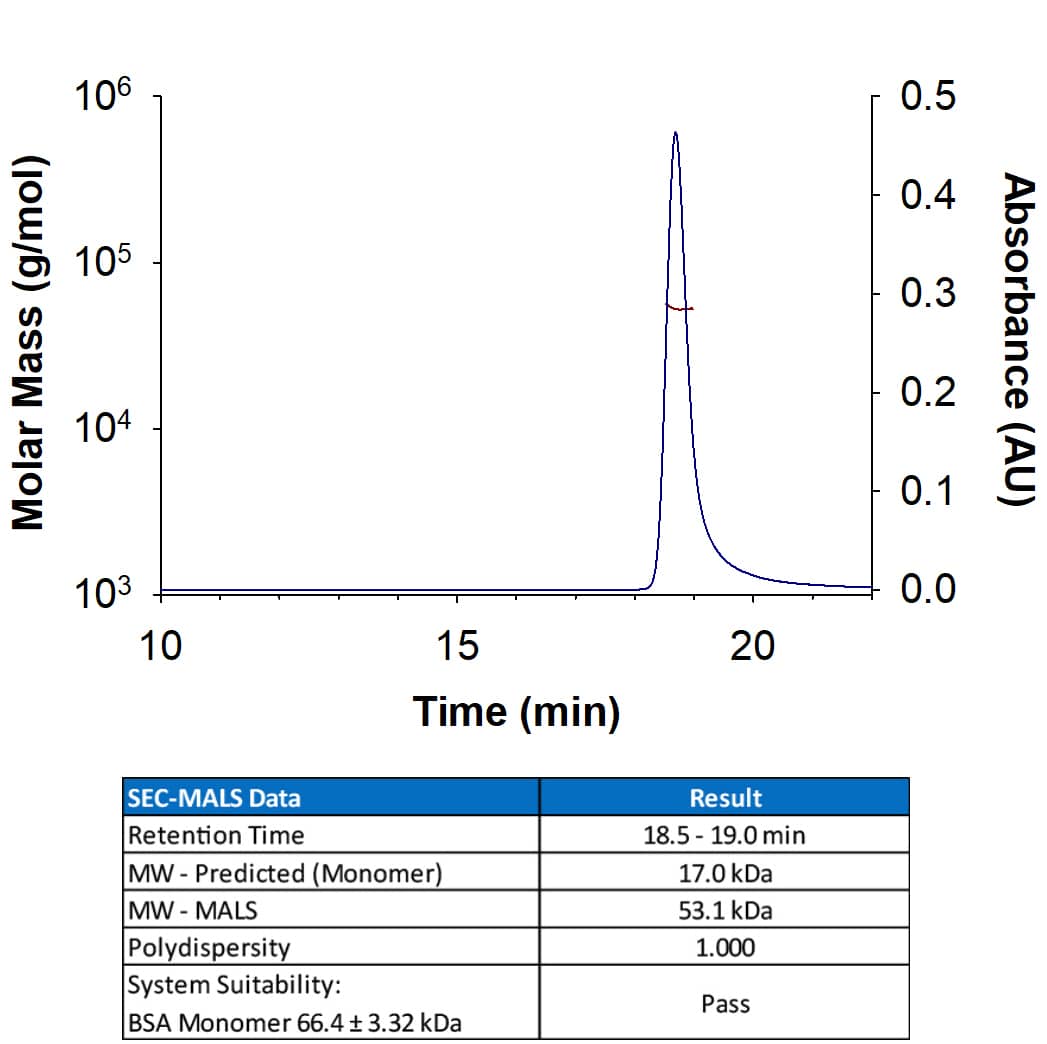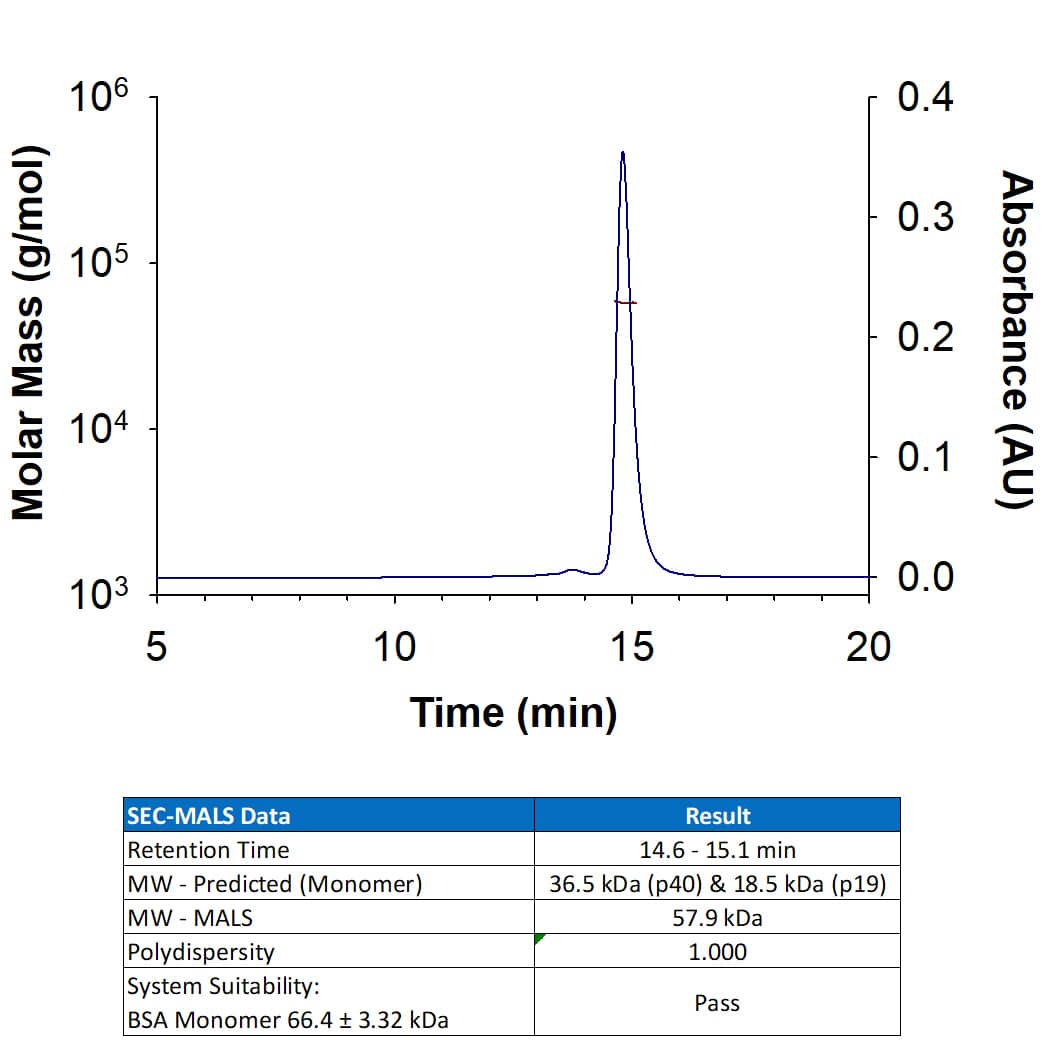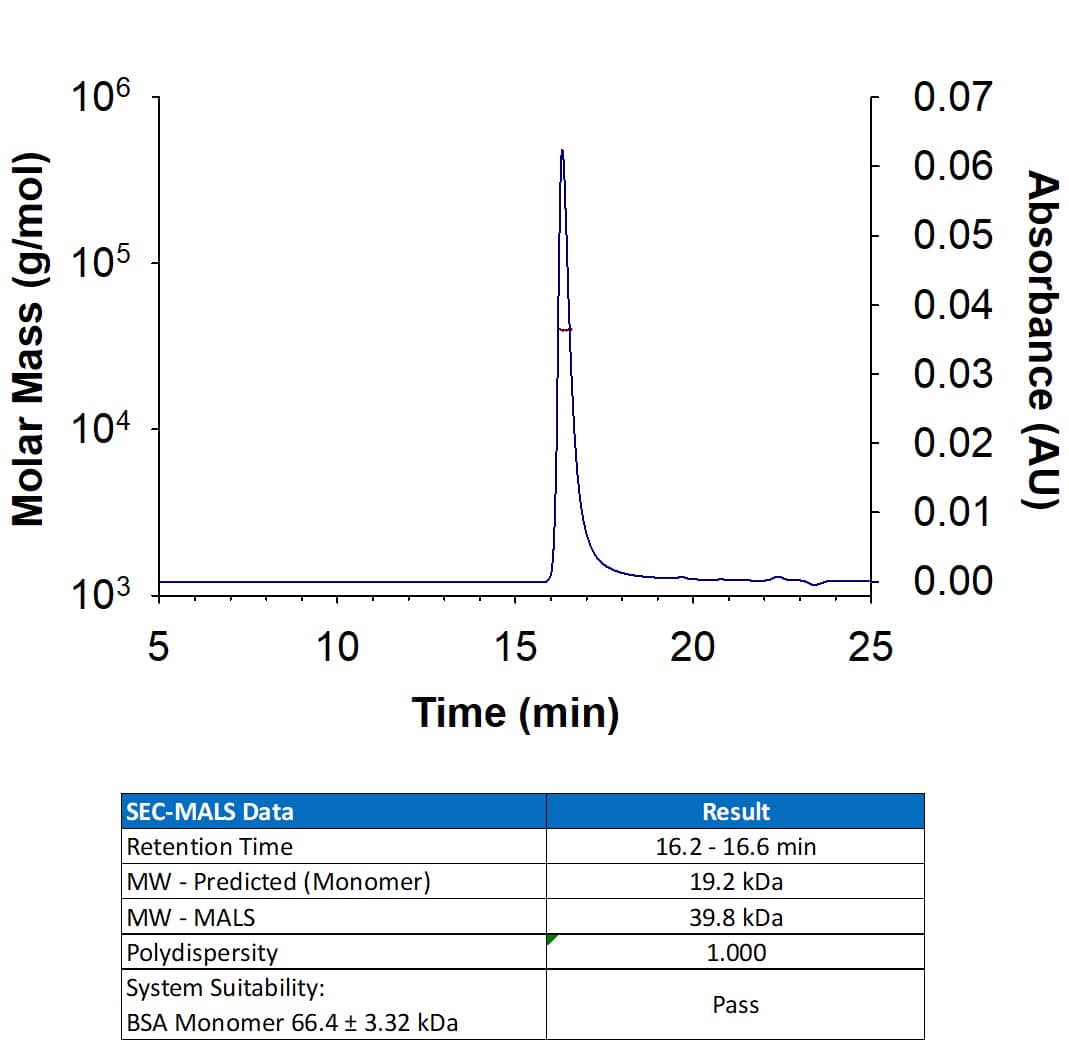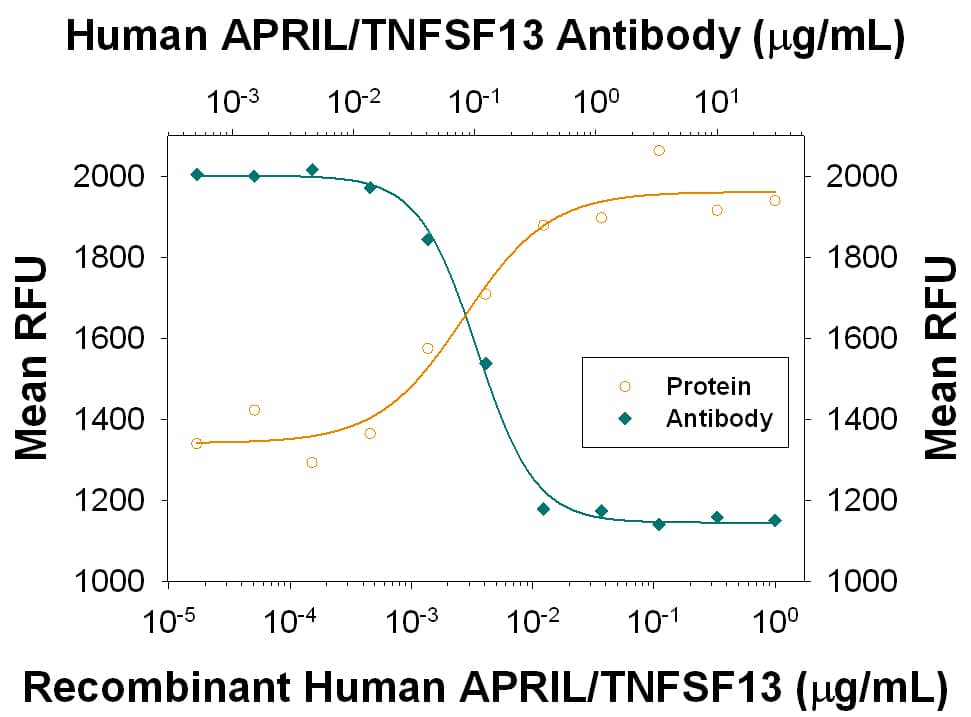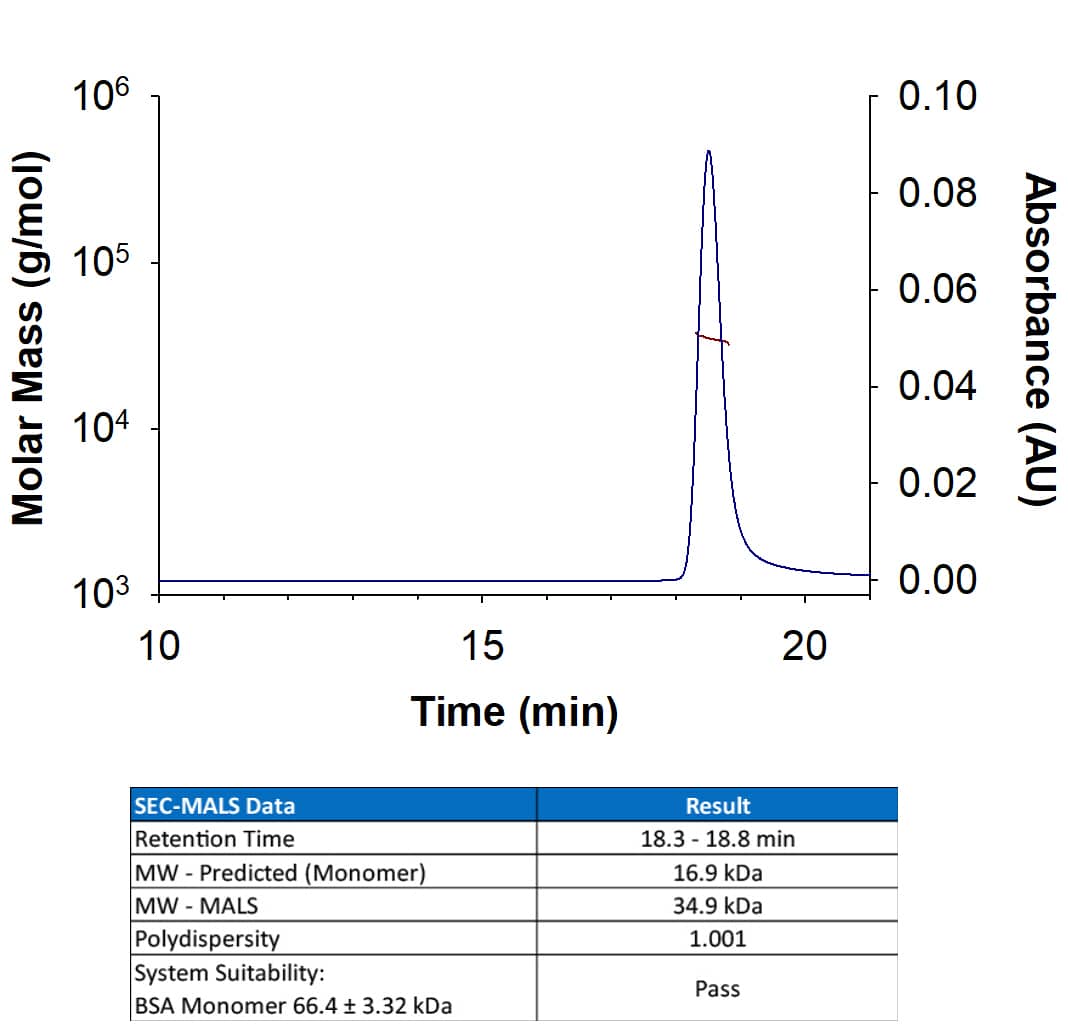Recombinant Human APRIL/TNFSF13
Recombinant Human APRIL/TNFSF13 Summary
Product Specifications
| MHHHHHHHHHH | GGGSGGGSGGGS | IEGR | Human APRIL (Lys110-Leu250) Accession # Q8NFH7 |
| N-terminus | C-terminus | ||
Analysis
Customers also Viewed
Product Datasheets
884-AP/CF (carrier free)
Discontinued Product
884-AP
| Formulation | Lyophilized from a 0.2 μm filtered solution in PBS and NaCl with BSA as a carrier protein. |
| Reconstitution | Reconstitute at 10 μg/mL in sterile PBS containing at least 0.1% human or bovine serum albumin. |
| Shipping | The product is shipped at ambient temperature. Upon receipt, store it immediately at the temperature recommended below. |
| Stability & Storage: | Store the unopened product at -20 to -70 °C. Use a manual defrost freezer and avoid repeated freeze-thaw cycles. Do not use past expiration date. |
Background: APRIL/TNFSF13
APRIL (a proliferation-inducing ligand), also known as TNFSF13, TALL2, TRDL1, and CD256, is a member of the TNF ligand superfamily (1). It is synthesized as a 32 kDa proprotein which is cleaved by furin in the Golgi to release the active 17 kDa soluble molecule (2-4). Secreted human APRIL, which consists almost entirely of a single TNF homology domain, shares 85% amino acid sequence identity with mouse and rat APRIL (2, 3). Both APRIL and its close relative BAFF bind and signal through the TNF superfamily receptors TACI and BCMA, while BAFF additionally functions through BAFF R (2, 5, 6). APRIL binds to heparan sulfate proteoglycans (HSPGs) independently of its binding to TACI and BCMA (6, 7). The interaction with HSPGs induces APRIL oligomerization, and this augments TACI-, or BMCA-mediated effects (7, 8). HSPGs are also critical for the tumor growth-promoting effects attributed to APRIL (6). APRIL can form bioactive heterotrimers with BAFF, and these circulate in the serum of patients with rheumatic immune disorders (10). TWE-PRIL is a bioactive hybrid protein produced by gene splicing. It consists of the intracellular domain, transmembrane segment, and stalk region of TWEAK fused to the TNF homology domain of APRIL (11). TWE-PRIL is expressed in monocytes and activated T cells and, in contrast to APRIL, is presented on the cell surface (11). APRIL enhances the proliferation and survival of plasma cells and also promotes T cell-dependent humoral responses (2, 12, 13). In the context of autoimmune disorders, however, APRIL can inhibit pathologic humoral responses as well as disease progression (14). Its expression by CD4+ T cells inhibits the production of Th2 cytokines and allergic inflammation (15). APRIL levels are elevated in the serum during coronary artery disease (16), and it is also elevated in many cancers primarily due to expression by tumor-infiltrating neutrophils (4, 7, 17).
- Planelles, L. et al. (2008) Curr. Mol. Med. 8:829.
- Yu, G. et al. (2000) Nat. Immunol. 1:252.
- Lopez-Fraga, M. et al. (2001) EMBO Reports 2:945.
- Kelly, K. et al. (2000) Cancer Res. 60:1021.
- Day, E.S. et al. (2005) Biochemistry 44:1919.
- Bossen, C. et al. (2006) J. Biol. Chem. 281:13964.
- Hendriks, J. et al. (2005) Cell Death Differ. 12:637.
- Schwaller, J. et al. (2007) Blood 109:331.
- Ingold, K. et al. (2005) J. Exp. Med. 201:1375.
- Roschke, V. et al. (2002) J. Immunol. 169:4314.
- Pradet-Balade, B. et al. (2002) EMBO J. 21:5711.
- Benson, M.J. et al. (2008) J. Immunol. 180:3655.
- He, B. et al. (2004) J. Immunol. 172:3268.
- Fernandez, L. et al. (2012) Ann. Rheum. Dis. 72:1367.
- Xiao, Y. et al. (2011) Eur. J. Immunol. 41:164.
- Sandberg, W.J. et al. (2009) Thromb. Haemost. 102:704.
- Mhawech-Fauceglia, P. et al. (2008) Eur. J. Cancer 44:2097.
Citations for Recombinant Human APRIL/TNFSF13
R&D Systems personnel manually curate a database that contains references using R&D Systems products. The data collected includes not only links to publications in PubMed, but also provides information about sample types, species, and experimental conditions.
3
Citations: Showing 1 - 3
Filter your results:
Filter by:
-
TNF superfamily member, TL1A, is a potential mucosal vaccine adjuvant.
Authors: Kayamuro H, Yoshioka Y, Abe Y, Katayama K, Yoshida T, Yamashita K, Yoshikawa T, Hiroi T, Itoh N, Kawai Y, Mayumi T, Kamada H, Tsunoda S, Tsutsumi Y
Biochem. Biophys. Res. Commun., 2009-05-04;384(3):296-300.
Species: Mouse
Sample Types: In Vivo
Applications: In Vivo -
IL-21 and BAFF/BLyS synergize in stimulating plasma cell differentiation from a unique population of human splenic memory B cells.
Authors: Ettinger R, Sims GP, Robbins R, Withers D, Fischer RT, Grammer AC, Kuchen S, Lipsky PE
J. Immunol., 2007-03-01;178(5):2872-82.
Species: Human
Sample Types: Whole Cells
Applications: Bioassay -
BAFF and APRIL protect myeloma cells from apoptosis induced by interleukin 6 deprivation and dexamethasone.
Authors: Moreaux J, Legouffe E, Jourdan E, Quittet P, Reme T, Lugagne C, Moine P, Rossi JF, Klein B, Tarte K
Blood, 2003-12-04;103(8):3148-57.
Species: Human
Sample Types: N/A, Whole Cells
Applications: Bioassay, ELISA (Standard)
FAQs
No product specific FAQs exist for this product, however you may
View all Proteins and Enzyme FAQsReviews for Recombinant Human APRIL/TNFSF13
There are currently no reviews for this product. Be the first to review Recombinant Human APRIL/TNFSF13 and earn rewards!
Have you used Recombinant Human APRIL/TNFSF13?
Submit a review and receive an Amazon gift card.
$25/€18/£15/$25CAN/¥75 Yuan/¥2500 Yen for a review with an image
$10/€7/£6/$10 CAD/¥70 Yuan/¥1110 Yen for a review without an image





